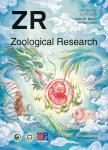Birth seasonality and pattern in black-and-white snub-nosed monkeys (Rhinopithecus bieti) at Mt. Lasha, Yunnan
Birth seasonality and pattern in black-and-white snub-nosed monkeys (Rhinopithecus bieti) at Mt. Lasha, Yunnan作者机构:Key Laboratory of Forest Disaster Warning and Control in Yunnan Province Southwest Forestry University Kunming Yunnan 650224 China Bureau of Yunling Provincial Nature Reserve Lanping Yunnan 671400 China College of Life Science and Technology Central South University of Forestry and Technology Changsha Hunan 410004 China Institute of Eastern-Himalaya Biodiversity Research Dali University Dali Yunnan 671003 China
出 版 物:《Zoological Research》 (动物学研究(英文))
年 卷 期:2014年第35卷第6期
页 面:474-484页
核心收录:
学科分类:1002[医学-临床医学] 07[理学] 0713[理学-生态学]
基 金:Foundation items: This study was supported by the National Natural Science Foundation of China (31160422 30960084) China Postdoctoral Science Foundation (2013M542379) Program for New Century Excellent Talents in University (NCET-12-1079) and Key Subject of Wildlife Conservation and Utilization in Yunnan Province We thank the directors and staff from the Administrative Bureau of Yunling National Reserve Lanping County Nujiang Prefecture Yunan Province the residents of Dashanqing village and assistants Qing-Sheng Su and Jin-Fu Zhang
主 题:Rhinopithecus bieti Birth seasonality Birth pattern Birth synchrony
摘 要:Seasonal variation in environmental factors is vital to the regulation of seasonal reproduction in primates. Consequently, long-term systematic data is necessary to clarify the birth seasonality and pattern of primates in highly seasonal environments. This study indicated that black-and-white snub-nosed monkeys (Rhinopithecus bieti) at Mt. Lasha exhibited strict birth seasonality with a pulse model. Infants were born with a certain degree of synchronization. Birth distribution showed three birth peaks, and the birth pattern showed a "V" style in even-numbered years and a gradual increase in odd-numbered years. The beginning date, end date and median birth date were earlier in even-numbered years than those in odd-numbered years. The higher latitude of their habitats, earlier birth date, shorter birth period, fewer birth peaks and stronger birth synchrony might be adaptations for strongly seasonal variation in climate and food resources. After the summer solstice when daylight length began to gradually shorten, R. bieti at Mt. Lasha started to breed during the period with the highest environmental temperature and food availability, which implied that photoperiod may be the proximate factor triggering the onset of estrus and mating. It appears that R. bieti coincided conception and mid-lactation with the peak in staple foods, and weaning with the peak in high quality of foods. Thus, food availability was the ultimate factor regulating reproductive seasonality, and photoperiod was the proximate factor fine-turning the coordination between seasonal breeding and food availability.



